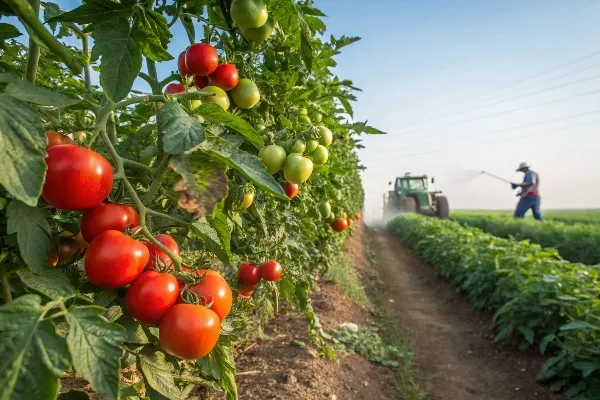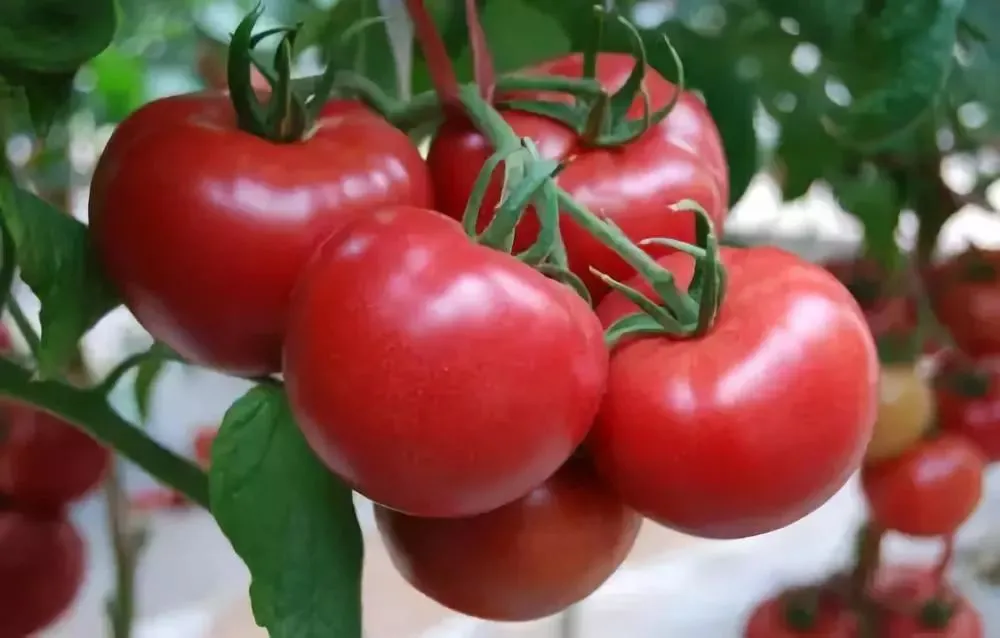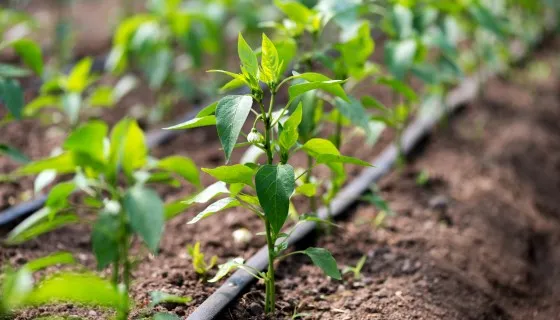Avoid your inquiry is delay response, please enter your WhatsApp/Skype along with the message, so we can contact you at the very first time.
We will reply you within 24 hours. If for urgent case, please add WhatsApp/WeChat:
Warning: Undefined variable $public in /www/wwwroot/lvfertilizer.com/wp-content/themes/hyhadmin/header.php on line 350
Warning: Trying to access array offset on value of type null in /www/wwwroot/lvfertilizer.com/wp-content/themes/hyhadmin/header.php on line 350
,. Or call
Warning: Undefined variable $public in /www/wwwroot/lvfertilizer.com/wp-content/themes/hyhadmin/header.php on line 350
Warning: Trying to access array offset on value of type null in /www/wwwroot/lvfertilizer.com/wp-content/themes/hyhadmin/header.php on line 350
directly.
You want bigger tomato fruit but see small harvests. The problem is often the wrong fertilizer at the wrong time. That limits fruit and wastes money. The fix is simple: match the tomato stage with the right fertilizer and add calcium to protect the fruit.
To increase tomato fruit size, use a tomato fertilizer that is balanced early, then higher in potassium during flowering and fruit fill (for example, NPK 12-12-36 or 15-15-30). Keep nitrogen steady—enough for plant growth, not too much—and supply calcium to prevent blossom end rot. Apply through drip or as a water-soluble fertilizer during fruit set and fruit fill for best results.

Bigger tomato fruit comes from steady nutrient supply. Think of the tomato plant like a factory. It needs power (nitrogen), frame (phosphorus and calcium), and the conveyor belt (potassium) to move sugars into the fruit. When those parts of plants work together, the tomato grows and the tomato yield rises.
Too much nitrogen pushes vegetative growth (leaf and foliage). That looks lush but starves the fruit. Enough nitrogen early, then more potassium later, is how you improve tomato size without losing flavor or fruit quality. For growers who want a ready-to-use option, see a high-K program such as NPK 12-12-36 water-soluble fertilizer for fruit fill (helpful catalog reference and specs).
Tomatoes need different nutrition as they move from new plants to harvest. A balanced fertilizer helps early roots. As flowers appear, the fertilizer to use shifts toward potassium for sugar movement and fruit development.
Here is a simple stage view:
| Stage (weeks) | Aim | Typical N-P-K shape | Notes |
|---|---|---|---|
| Establishment | Roots & leaves | Even N-P-K (e.g., 20-20-20) | Gentle, steady feed helps tomato plants require strong starts. |
| Pre-bloom | Buds & stems | Slightly more P | Supports early flower clusters and fruit formation. |
| Bloom to fruit fill | Big fruit | High-K (e.g., 12-12-36 or 15-15-30) | Moves sugars; add calcium to keep healthy fruit. |
For the high-K step, many growers pick NPK 15-15-30 water-soluble fertilizer during weeks during the growing season when fruit is sizing, because such fertilizers tend to support optimal fruit fill and color.

During fruit fill, potassium acts like a pump. It helps the plant move sugars to the fruit, building weight and flavor. A program with fertilizer high in potassium after fruit starts can increase average size of tomatoes and improve shelf life.
Explore a high-K option like NPK 12-12-36 (water-soluble) for drip or fertigation to give your tomatoes steady K without salt spikes. If you blend on site, a BB fertilizer (bulk blending) lets you tailor the type of fertilizer to your field and growing conditions.
You need nitrogen to help plants grow and set many tomatoes, but much fertilizer as N leads to vines, not fruit. The right amount of nitrogen changes with soil and weather. A quick soil test before planting tells you where to start.
Use an even form of nitrogen early to build canopy, then taper during fruit set so sugars go to fruit. Controlled programs with slow-release fertilizer at transplant, plus a shift to high-K water-soluble fertilizer, are common in open fields for best results. If you need an N source with added benefits, ammonium sulfate supplies N and sulfur for tomato growth in cool soils.
Calcium builds strong cell walls. Without it, the fruit can collapse at the tip—blossom end rot. That ruins fruit quality fast. Keep water steady and add calcium fertilizers when flowering and fruit begin.
Many growers pair high-K feeding with a calcium top-up. In some regions, calcium ammonium nitrate (CAN) is used to give your plants both N and Ca while keeping healthy tomatoes firm. The goal is to help cells develop fruit that resists cracking and ships well.
Drip is the gold standard for even delivery. It feeds plants throughout the root zone and limits loss. A single foliar pass can help during stress, but it’s a helper, not the main meal. Choose the method that keeps nutrients moving each week throughout the growing season.
If you prefer easy mixing, choose a water-soluble fertilizer (like 20-20-20 early, then 12-12-36 later) or a true liquid fertilizer for pump systems. These dissolve fast, so plants get what they need when they need it.

Both can work. Organic fertilizer adds organic material that improves soil life. Rich soil helps roots breathe and carry nutrient flows to each tomato. That supports growth and fruit development over time.
Chemical fertilizers (also called synthetic fertilizers) act fast and are easy to meter. Many commercial tomato fields use a mix: a base of compost, then precise soluble feeds at sizing. If you want natural inputs only, there are organic fertilizer options for growing tomatoes that still support big fruit. Choose what fits your market and your tomato crop.
Yes. Tomato varieties differ. Plum types pack solids; cherry tomatoes set many tomatoes but small; beefsteaks chase size. The type of tomato you grow sets how you aim the program. Large slicers may want more K during fruit fill to hit premium size.
Remember that tomato plants need enough roots before heavy fruit loads. Start even, then switch to higher K as fruit formation takes off. For growers who pack big slicers, a high-K tomato fertilizer formulated for tomatoes can help you grow and produce uniform loads. See high-K compound options like NPK 12-10-30 for sizing.
Here’s a practical, no-rate schedule (always follow local guidance and your soil before planting test):
If you blend your own, custom fertilizer blends (BB fertilizer) let you dial in K and Ca for your field blocks. If you want a pre-mix, a water-soluble npk fertilizer like NPK 20-20-20 for early growth, then NPK 12-12-36 for sizing, is a simple two-step.
If your tomato plants get lush but small fruit, try switching mid-season to a high-K fertilizer like NPK 15-15-30 or NPK 12-12-36 and add Ca for the next set. This helps increase fruit size on later trusses.
This simple “chart” shows how the fertilizer focus shifts over time so tomatoes thrive and develop fruit evenly.
As a leading manufacturer and exporter of high-quality fertilizer products based in China, we see diverse climates and soils. Simple habits separate average from growing great crops:
If you want help choosing the best fertilizer for tomatoes, our team can suggest ready formulas or custom fertilizer blends for your market.
Explore: NPK 20-20-20, NPK 15-15-30, NPK 12-12-36, BB fertilizer (for mixing fertilizer to spec), ammonium sulfate, and CAN fertilizer options (catalog pages for specs and export support).
What is the best tomato fertilizer to use if I want larger fruit?
Use a high-K blend during fruit fill, such as 12-12-36 or 15-15-30. That’s the best tomato fertilizer to use for weight and color, while keeping enough nitrogen to avoid stalls.
How often should I feed your plants for bigger tomatoes?
Feed little and often. Small, steady doses help plants need stable nutrition and avoid salt spikes that can damage plants. Use drip if possible to feed your plants evenly.
Can I add fertilizer mid-season without hurting the crop?
Yes. You can add fertilizer mid-season as you switch from canopy to sizing. Just avoid big N jumps once fruit is filling.
Do homemade tomato feeds work?
A homemade tomato feed (like light compost tea) can help roots and soil life, but use it as a helper. For sizing, go with a known high-K blend to support fruit size and yield.
What about foliar sprays for rescue?
One foliar spray can help during stress or cold snaps, but the base program should stay in the root zone for steady uptake.
Do chemical fertilizers beat organic in fruit size?
Both can work. Organic fertilizer builds soil; chemical fertilizers are precise. Many commercial growers combine them for best results and reliable fruit production.
Even simpler cheat-sheet
+25 %
Average increase in fruit size when switching to high-K feed at fruit fill.
Zero cases of blossom end rot in trials with added calcium.
2-step program: balanced early ➜ high-potassium later for optimal tomato yield.
Figure 1 – Nutrient focus shifts through the tomato growing season.